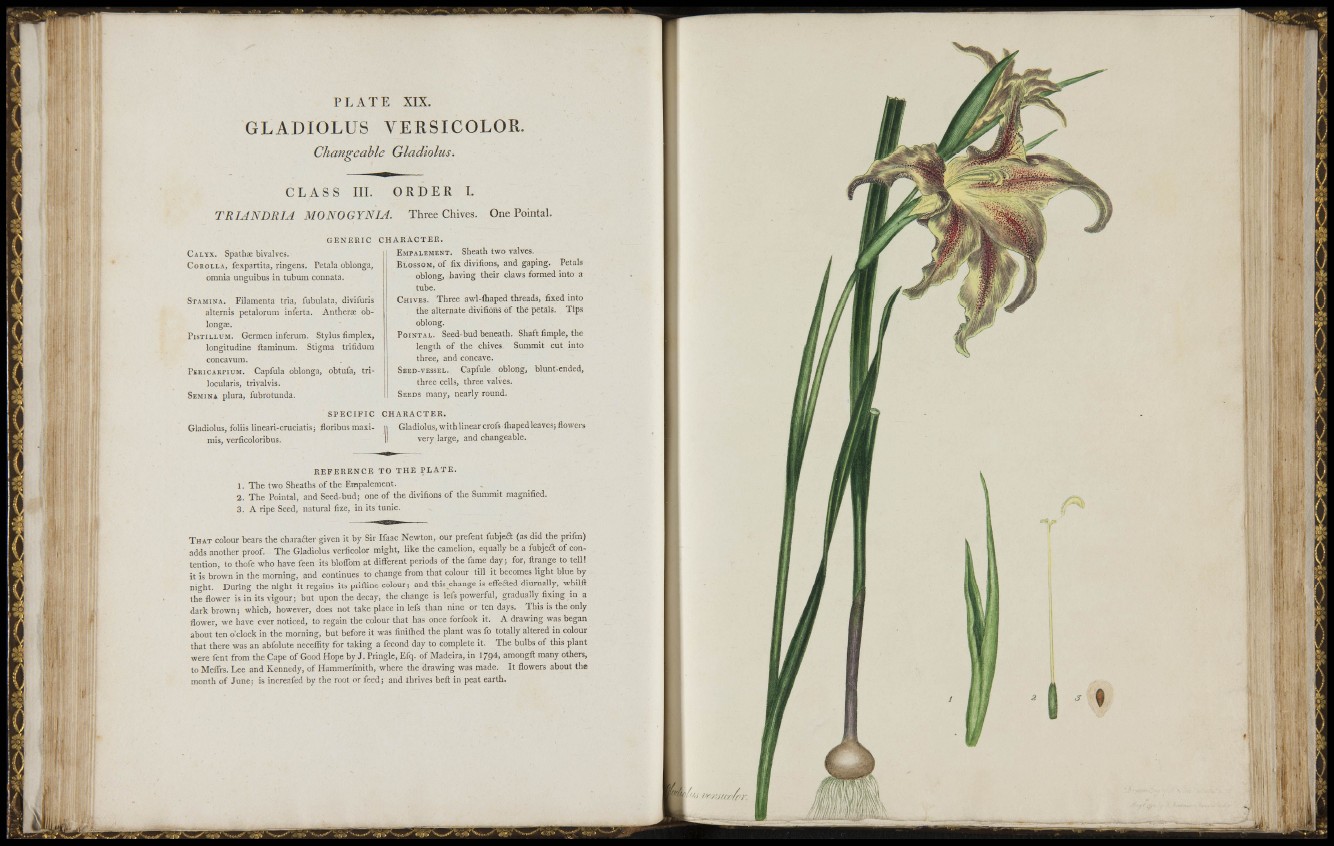
:
i
li
11: I
PLATE XIX.
GLADIOLUS VERSICOLOR.
Changeahle Gladiolus.
CLASS m. ORDER L
TRIAN DRIA MONOGYNIA. Three Chives. One Pointal.
GENERIC
CALÏX. Spathae bivalves.
COROLLA, fexpartita, ringens. Pétala oblonga,
omnia unguibus in tubum connata.
STAMINA. Filamenta tria, fubulata, divifuris
alte.rnis petalorum infetta. Antherae oblongse.
PisTiLLUM. Germen inferum. Stylus limplex,
longitudine flaminum. Stigma trifidum
conca vum.
P E R I C A K P I U M . Capfula oblonga, obtufa, trilocularis,
trivalvis.
S E M I N A plura, fubrotunda.
S P E C I F I C
Gladiolus, foliis lineari-cruciatis; floribus maxirais,
verficoloribus.
CHARACTEIÎ.
EMPALEMENT. Sheath two valves.
BLOSSOM, of fix divifions, and gaping. Petals
oblong, having their claws formed into a
tube.
CHIVES. Three awl-fliaped threads, fixed into
the alternate divifions of tlie petals. Tips
oblong.
POINTAL. Seed-bud beneath. Shaft fimple, the
length of the chives. Summit cut into
three, and concave.
S E E D - V E S S E L . Capfule oblong, blunt-ended,
three cells, three valves.
S E E D S many, nearly roimd.
CHARACTER.
Gladiolus, with linear crofs fliapedleaves; flowers
very large, and changeable.
REFERENCE TO THE PLATE.
1. The two Sheaths of the Empalement.
2. The Pointal, and Seed-bud: one of the divifions of the Summit magnified.
3. A ripe Seed, natural fize, in its tunic.
T H A T colour bears the chcirafter given it by Sir Ifaac Newton, our prefent fubjed (as did the prifm)
adds another proof. The Gladiolus veriicolor might, like the camelion, equally be a fubjed of contention,
to thofe who have feen its bloffbm at different periods of the fame day; for, ftrange to tell!
it is brown in the morning, and continues to change from that colour till it becomes light blue by
night. During the night it regains its priftine colour; and this change is efFefted diurnally, whilft
the flower is in its vigour; but upon the decay, the change is lets powerful, gradually fixing in a
dark brown; which, however, does not take place in lefs than nine or ten days. This is the only
flower, we have ever noticed, to regain the colour that has once forfook it. A drawing was began
about ten o'clock in the morning, but before it was finiflied the plant was fo totally altered in colour
that there was an abfolute neceflity for taking a fécond day to complete it. The bulbs of this plant
were fent from the Cape of Good Hope by J . Pringle, Efq. of Madeira, in 1794, amongft many others,
to MeflTrs. Lee and Kennedy, of Hamraerfmith, where the drawing was made. It flowers about the
month of June; is increafed by the root or feed; and thrives beft in peat earth.